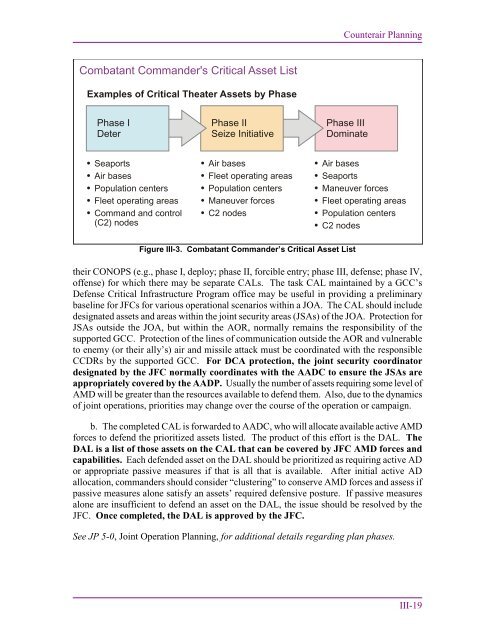JP 3-01 Countering Air and Missile Threats - Defense Innovation ...
JP 3-01 Countering Air and Missile Threats - Defense Innovation ...
JP 3-01 Countering Air and Missile Threats - Defense Innovation ...
Create successful ePaper yourself
Turn your PDF publications into a flip-book with our unique Google optimized e-Paper software.
Counterair Planning<br />
Combatant Comm<strong>and</strong>er's Critical Asset List<br />
Examples of Critical Theater Assets by Phase<br />
Phase I<br />
Deter<br />
Phase II<br />
Seize Initiative<br />
Phase III<br />
Dominate<br />
• Seaports<br />
• <strong>Air</strong> bases<br />
• Population centers<br />
• Fleet operating areas<br />
• Comm<strong>and</strong> <strong>and</strong> control<br />
(C2) nodes<br />
• <strong>Air</strong> bases<br />
• Fleet operating areas<br />
• Population centers<br />
• Maneuver forces<br />
• C2 nodes<br />
• <strong>Air</strong> bases<br />
• Seaports<br />
• Maneuver forces<br />
• Fleet operating areas<br />
• Population centers<br />
• C2 nodes<br />
Figure III-3. Combatant Comm<strong>and</strong>er’s Critical Asset List<br />
their CONOPS (e.g., phase I, deploy; phase II, forcible entry; phase III, defense; phase IV,<br />
offense) for which there may be separate CALs. The task CAL maintained by a GCC’s<br />
<strong>Defense</strong> Critical Infrastructure Program office may be useful in providing a preliminary<br />
baseline for JFCs for various operational scenarios within a JOA. The CAL should include<br />
designated assets <strong>and</strong> areas within the joint security areas (JSAs) of the JOA. Protection for<br />
JSAs outside the JOA, but within the AOR, normally remains the responsibility of the<br />
supported GCC. Protection of the lines of communication outside the AOR <strong>and</strong> vulnerable<br />
to enemy (or their ally’s) air <strong>and</strong> missile attack must be coordinated with the responsible<br />
CCDRs by the supported GCC. For DCA protection, the joint security coordinator<br />
designated by the JFC normally coordinates with the AADC to ensure the JSAs are<br />
appropriately covered by the AADP. Usually the number of assets requiring some level of<br />
AMD will be greater than the resources available to defend them. Also, due to the dynamics<br />
of joint operations, priorities may change over the course of the operation or campaign.<br />
b. The completed CAL is forwarded to AADC, who will allocate available active AMD<br />
forces to defend the prioritized assets listed. The product of this effort is the DAL. The<br />
DAL is a list of those assets on the CAL that can be covered by JFC AMD forces <strong>and</strong><br />
capabilities. Each defended asset on the DAL should be prioritized as requiring active AD<br />
or appropriate passive measures if that is all that is available. After initial active AD<br />
allocation, comm<strong>and</strong>ers should consider “clustering” to conserve AMD forces <strong>and</strong> assess if<br />
passive measures alone satisfy an assets’ required defensive posture. If passive measures<br />
alone are insufficient to defend an asset on the DAL, the issue should be resolved by the<br />
JFC. Once completed, the DAL is approved by the JFC.<br />
See <strong>JP</strong> 5-0, Joint Operation Planning, for additional details regarding plan phases.<br />
III-19

















